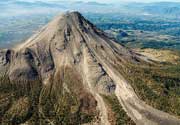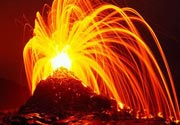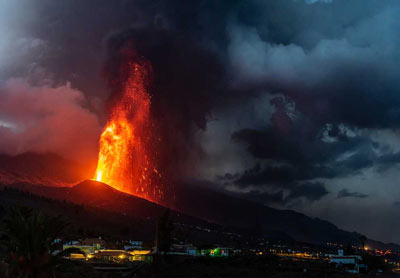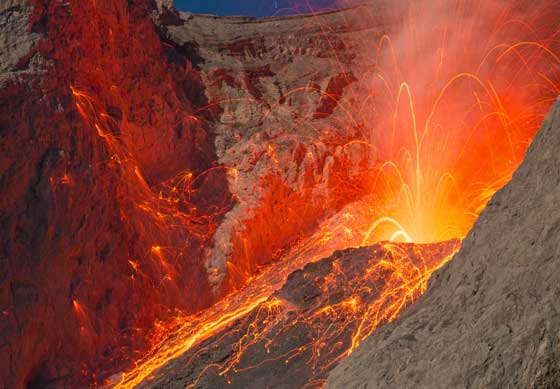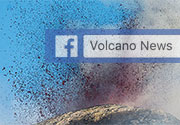Continuous Ash Emissions from Voragine Crater
Update Sun 11 Jan 21:39

Ash emissions from Voragine Crater (photo: Emanuela / VolcanoDiscovery Italia)
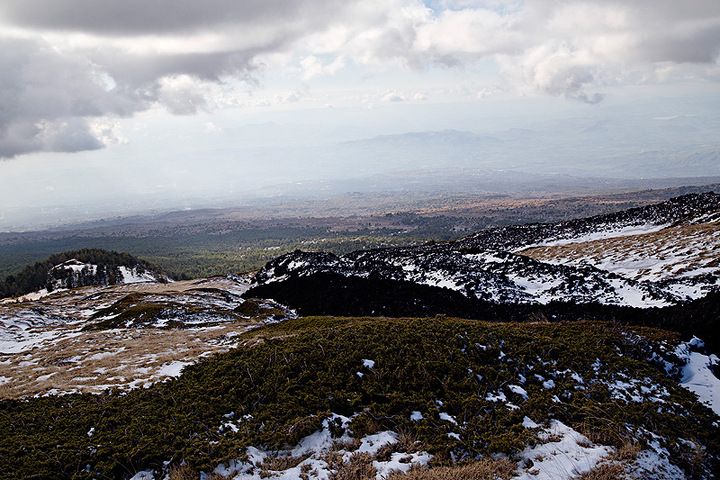
The front of the lava flow of the last paroxysm on the SW flank (photo: Emanuela / VolcanoDiscovery Italia)
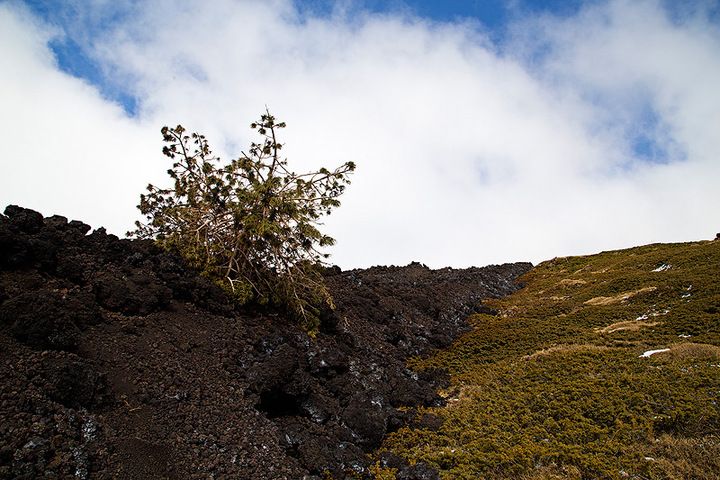
A knocked-down tree lay on the lava flow (photo: Emanuela / VolcanoDiscovery Italia)
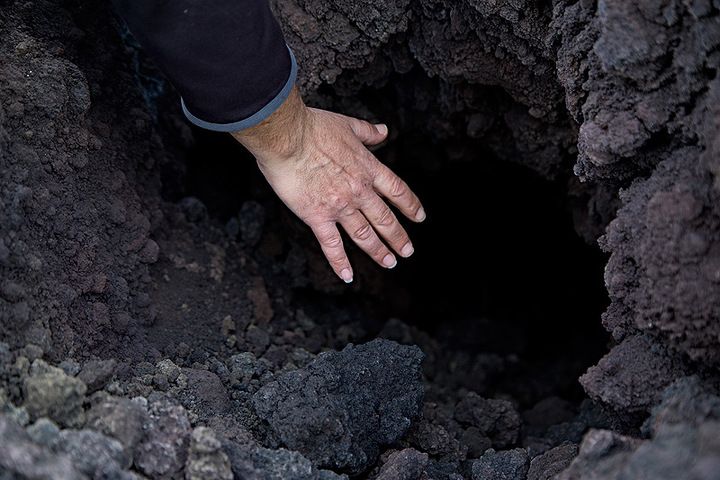
The hole of the fallen tree, still hot (photo: Emanuela / VolcanoDiscovery Italia)
Explosions and ash emissions of moderate intensity continue from the Voragine crater.
During a visit of the front of the cooling lava flow of last paroxysm on the southern side of the New SE crater it was possible to observe that the most advanced flow front is at 2130 m elevation at the side of 1942 lava flow in direction of M. Scavo.
Ash Emissions from the New SE Crater and Strombolian Activity at the Voragine Crater
Update Sat 03 Jan 22:37

Strombolian activity at Voragine crater this evening seen from Bronte (nicola76.beepworld webcam)
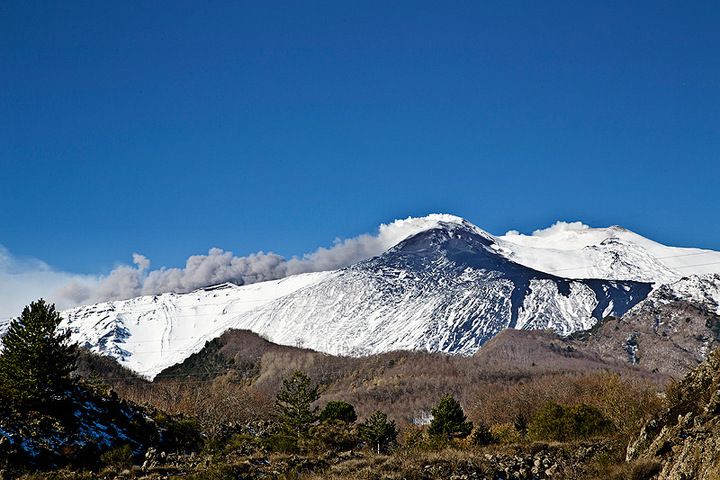
The lava flow of the last paroxysm on the SW flank ( (photo: Emanuela / VolcanoDiscovery Italia)
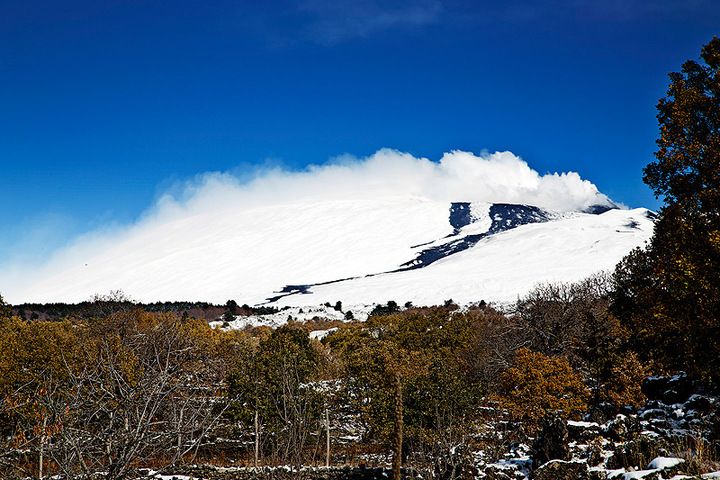
The lava flow of the last paroxysm on the eastern flank(photo: Emanuela / VolcanoDiscovery Italia)
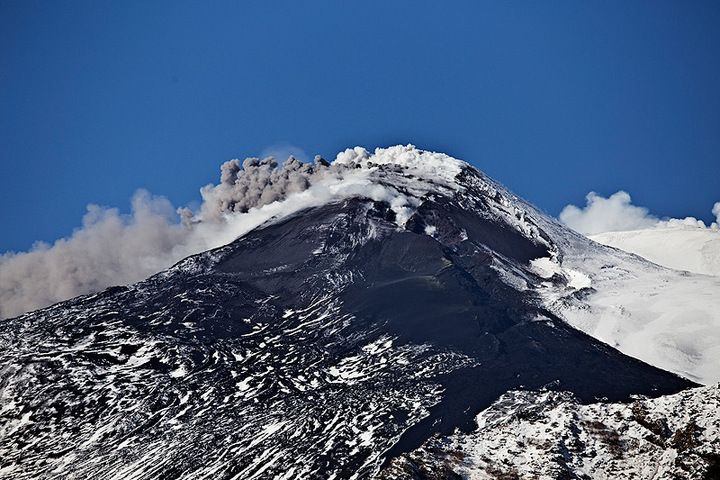
Ash emission from the New SE crater on 2nd January (photo: Emanuela / VolcanoDiscovery Italia)
Yesterday a dense pulsating ash column was emitted by deep-seated strombolian activity at the New SE Crater. The emissions produced a plume bended over by wind towards the SW and forcing the closure of Catania's airport.
This morning ash emissions from the New SE Crater ended.
With the return of good weather it has been possible to observe two eruptive fissures opened during last paroxysm: one on the southern side of the New SE Crater and one on its eastern flank. The fissure on the southern side produced a lava flow that descended directed toward the western side of mount Frumento Supino splitting into 2 branches and reaching an altitude of about 1900 metres above sea level. The fissure on the eastern side produced a lava flow that reached the base of the Valle del Bove. They are not active now
During the last days, glow was observed above the Voragine crater and now this strombolian activity is increasing with pyroclastic material ejected over the crater.
New Paroxysm on Etna
Update Mon 29 Dec 16:34

The activity seen from Linguaglossa (EtnaTrekking webcam)
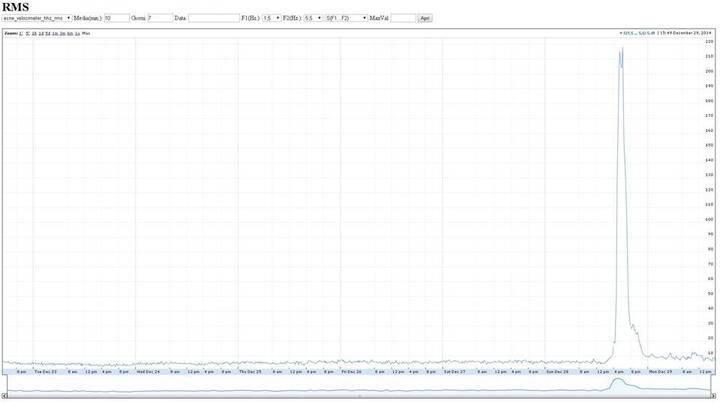
Tremor signal including the peak of activity (by courtesy of INGV-OE Catania)
Yesterday evening a new paroxysm occurred on Etna (last was on December 2nd, 2013).
Seismic tremor started to rise steeply about 16:00 (local time) followed by a strong seismo-volcanic event occurred at 16:50 (local time).
The brief but intense eruption was characterized by lava fountains and lava flows but bad visibility prevented to observe which craters were involved. Occasional views especially from the NE side permitted to see several fronts of lava flows descending the western slope into the Valle del Bove . The fountaining generated a column of gas and tephra that has rose a few km above the volcano and was then bent by the winds to the east.
The tremor signal started to decrease around 18:30 and it remains stable at slightly elevated levels.
Sporadic ash emissions from New SE crater
Update Fri 24 Oct 15:35
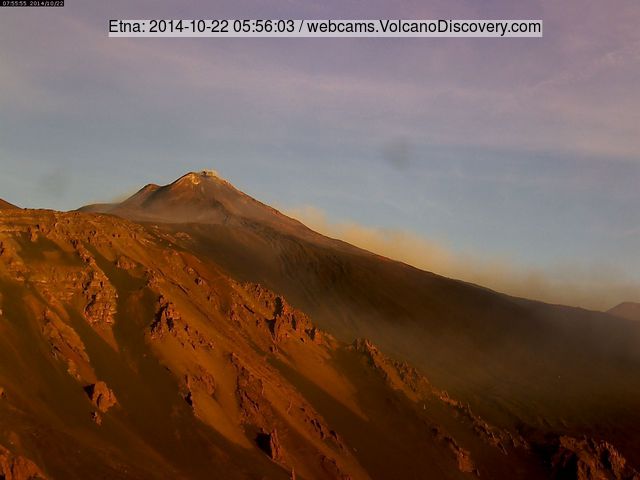
Small ash emission from Etna's New SE crater
Occasional explosions from the New SE crater seem to continue. Small ash emissions could be observed on the morning of 22 Oct when clear weather allowed clear views of the crater. Tremor remains low at the moment.
Update Mon 13 Oct 17:32
No significant changes have occurred. Intense degassing from the summit craters and weak northerly winds have been pushing a dense hazy vog ("volcanic smog") cloud over southern and southeastern sectors of Etna.
Weak explosions with emissions of small brown ash plumes have continued sporadically at the New SE crater at least until yesterday evening, but seem to have ceased or become even less frequent today. Tremor is low and does currently not suggest a paroxysm should be expected in the very near future.
Weak ash emissions from New SE crater
Update Sat 11 Oct 22:08
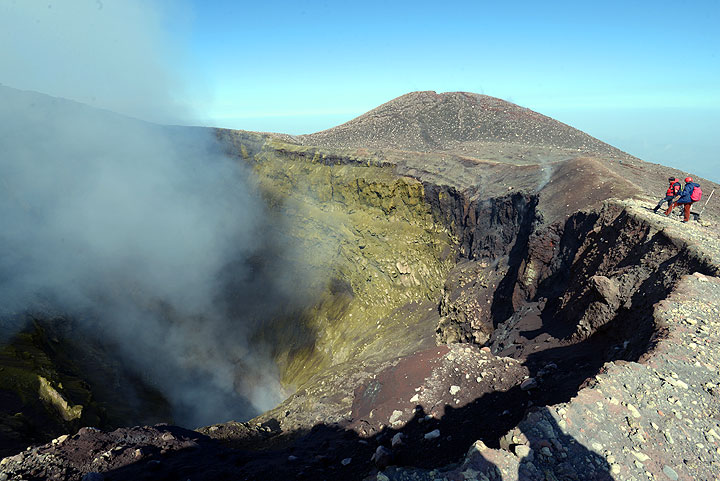
View into Etna's NEcrater today

Current tremor signal (ECPNZ station, INGV Catania)
There are no significant changes or signs of a new paroxysm very soon. Sporadic weak explosions with ash emissions continue at the New SE crater. Tremor has remained low.
The summit vents when observed today showed (normal) strong degassing, with audible deep-seated explosion sounds coming from the NE crater.
Activity resumes at Etna's New SE crater
Update Tue 07 Oct 22:19
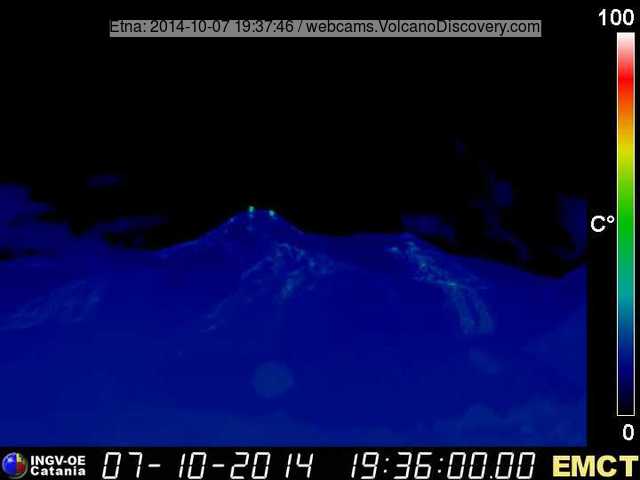
Small explosion from Etna's New SE crater (Monte Cagliato thermal webcam, INGV Catania)
After almost two months of apparent calm new activity resumes on Etna: Occasional weak explosions occur at the NSEC barely visible from thermal webcam images.
Activity ceases at New SE crater
Update Sun 17 Aug 17:20

Current tremor signal (ECPNZ station, INGV Catania)
Effusive / explosive activity from the New SE crater gradually declined and ceased over the weekend. The latest eruptive episode is now over.
Intense strombolian activity and lava flows from New SE crater
Update Wed 13 Aug 19:17
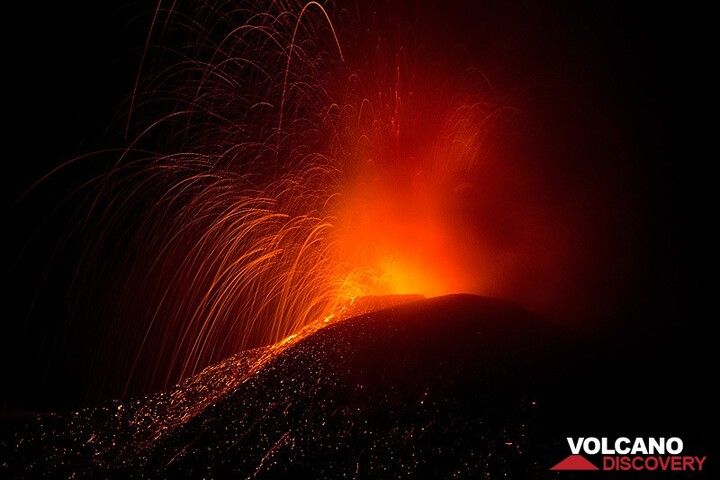
Powerful explosion at Etna New SE crater on 11 Aug 2014 (Photo: Emanuela / VolcanoDiscovery Italia)
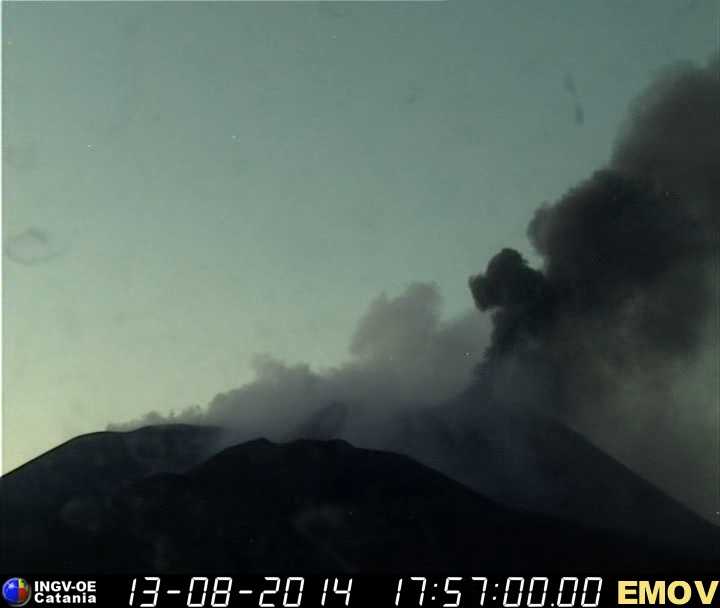
Ash-rich strombolian activity at the NSEC this evening

Current tremor amplitude (ESLN station, INGV Catania)
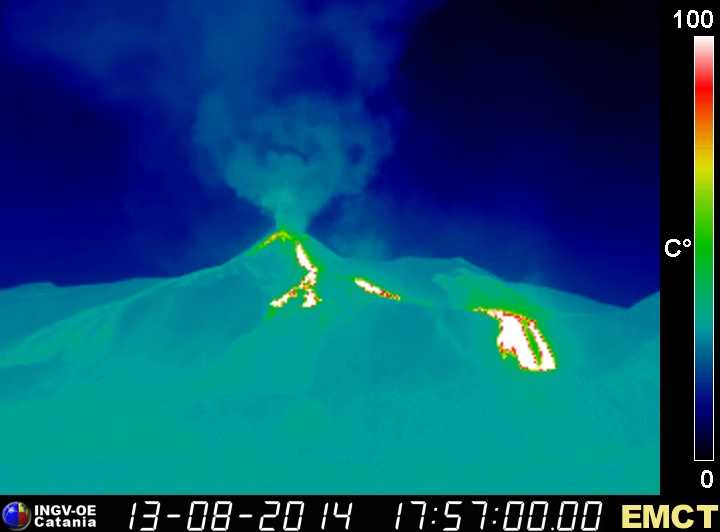
Thermal image of Etna's active lava flows from the New SE crater (Monte Cagliato thermal webcam, INGV Catania)
Strong strombolian explosions in rapid succession and lava effusion continue from the New SE crater with little variation during the past days. An ash plume is rising a few 100 m. Tremor has dropped a bit yesterday, but remains elevated.
Whether Etna is heading towards a true paroxysm with lava fountains is unclear, but if the new phase of activity is similar to the previous episodes, it might continue the same type of activity at fluctuating levels for a while and then fade.
The lava flow's main branch, issued from a fissure vent at the upper eastern rim of the NSEC, is headed to the northeast and has now a length of approx. 2 km. Its wide active front has reached the base of the Valle del Bove. Two secondary arms divide from the main flow and are flowing more to the east towards the break in slope into the Valle del Bove east of the NSEC (s. thermal image).
This new activity at the New SE crater had started on 9 August and gradually intensified until Monday, then dropped a bit and has been stagnating since.
Along with the appearance of lava at the NSEC, the explosive-effusive activity from the vents at the eastern base of the NE crater, which had continued through the past weeks, gradually waned and ceased on 10 or 11 Aug.
Update Wed 06 Aug 14:50
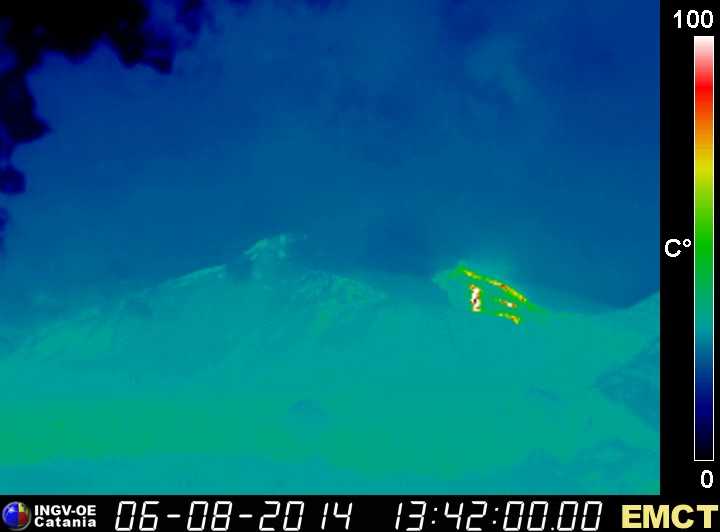
Thermal image of Etna's active lava flows from the effusive vent at the base of the NE crater (Monte Cagliato thermal webcam, INGV Catania)

Current tremor signal (ECPNZ station, INGV Catania)
Decreasing tremor and weakening thermal signals suggest that the explosive / effusive activity from the vents at the eastern foot of the NE crater still continues, but at reduced rate. At least one lava flow seems to be still active.
Continuing strombolian activity and lava flows
Update Mon 04 Aug 17:18
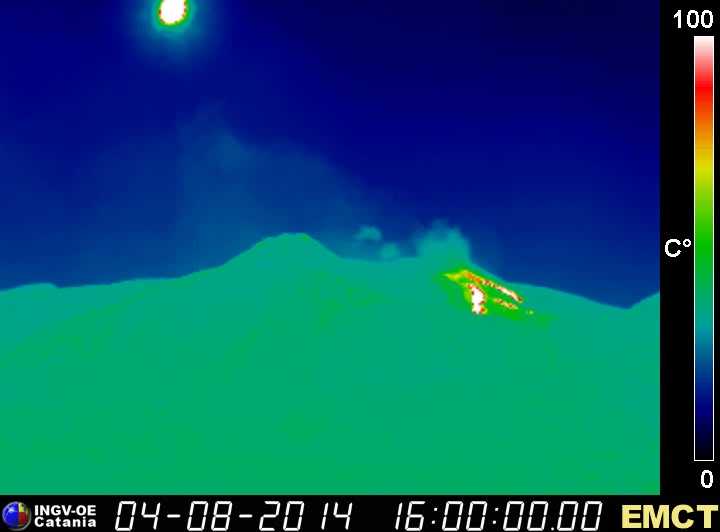
Thermal image of Etna's active lava flows from the effusive vent at the base of the NE crater (Monte Cagliato thermal webcam, INGV Catania)

Current tremor amplitude (ESLN station, INGV Catania)
No significant changes have occurred at the volcano recently. Lava continues to arrive at the vent(s) at the eastern base of the NE crater, where strombolian activity is building up a complex cone and several small lava flows are spreading towards the Valle del Bove.
A small collapse occurred on 1 August, partially destroying the cone that had been built above the 25 July vent.
Tremor reflecting the explosive activity there remains elevated, with strong fluctuations, but an overall decreasing trend.
The following video by Boris Behncke shows the activity on 2 August:
Opening of a new vent at E base of North-East Crater
Update Sat 26 Jul 00:41

Thermal image of the effusive vents at the base of the NE crater with the lava flow (Monte Cagliato webcam, INGV Catania)
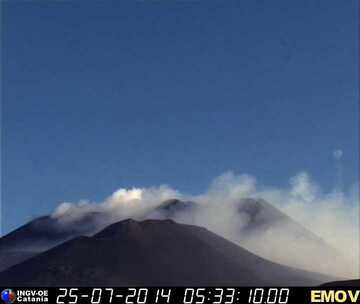
The New SE crater with a steam ring (Montagnola webcam, INGV Catania)
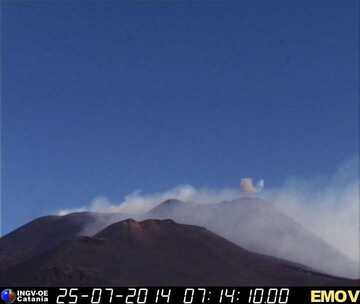
Ash emission from the New SE crater (Montagnola webcam, INGV Catania)
A new vent opened yesterday morning at 11:14 local time.
It is located about 150-200 metres north of the two previous vents at the eastern base of the NE crater.
Its activity is characterized by small strombolian explosions while a lava flow continues to be weakly alimented from one of the two other vents
In the meantime sporadic emissions of hot gas sometimes associated with ash emissions continue from the New SE crater .
Update Tue 15 Jul 20:39
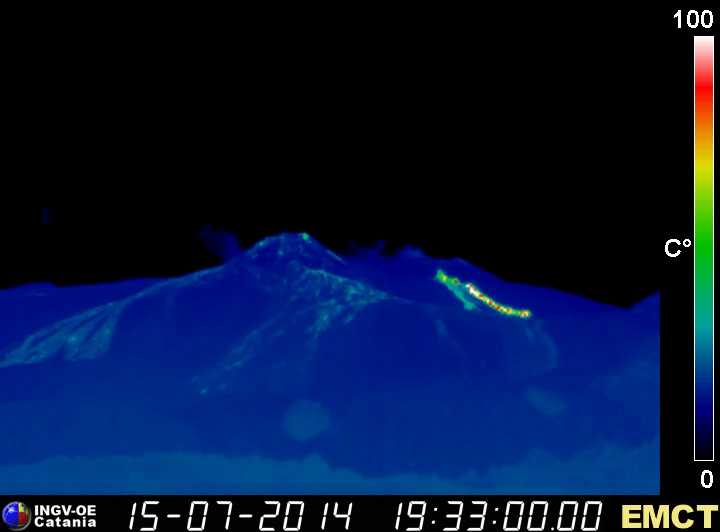
Thermal image of Etna's active lava flows from the effusive vent at the base of the NE crater (Monte Cagliato thermal webcam, INGV Catania)
The small effusive eruption continues with little variation. The northern branch of the lava flow slowly advances towards the Valle del Bove. Tremor fluctuates at moderately elevated levels.
Continuing lava flows, growing spatter cones
Update Mon 14 Jul 16:25

Thermal image of Etna's active lava flows from the effusive vent at the base of the NE crater

Current tremor signal (ECPNZ station, INGV Catania)
No significant variations in activity have occurred during the past days. Small lava flows are being fed by the new fissure vent at the eastern base of the NE crater. At the vent, this activity is accompanied by spattering, sometimes resembling strombolian-type explosions with ejections up to approx. 100 m in height.
2 spatter cones have been growing at the vents. They have been called "hornitos", although this term strictly spoken refers to smaller chimney-like structures that can form on top of skylights above lava tubes, where degassing jets throw out small amounts of lava to pile up to form them.
Starting from around 7 July, the lava flow has formed a second branch further to the north. Its furthest flow front has reached a length of approx. 1.5 km.
Tremor remains stable at slightly elevated levels.
Update Tue 08 Jul 07:18
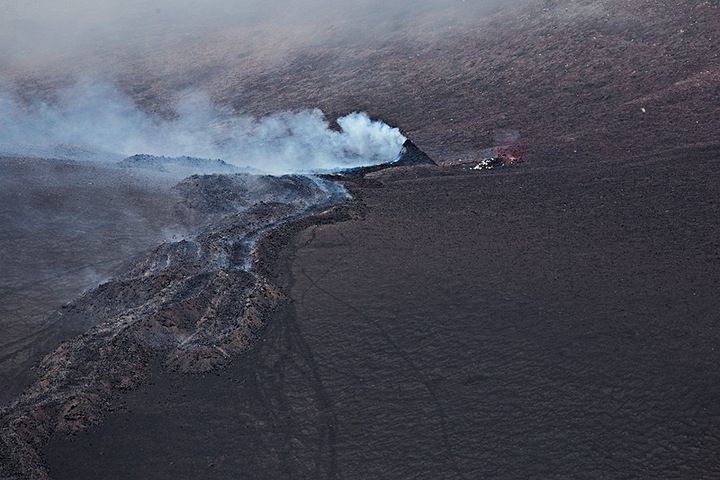
The new lava flows from the eastern base of Etna's NE crater on 6 July (photo: Emanuela / VolcanoDiscovery Italia)

The new lava flows from the eastern base of Etna's NE crater on 6 July (photo: Emanuela / VolcanoDiscovery Italia)
no significant changes: lava continues to effuse from the new fissure vent at the eastern base of the NE crater. A small hornito has grown at the vent. Tremor continues to climb slowly. Emanuela visited the active lava flows yesterday:
Continuing lava flows from new fissure.
Update Mon 07 Jul 18:26
The lava flow continues to advance slowly from the new fissure vent into the Valle del Leone. Tremor has been rising gradually overall, but is still low.
The following time-lapse from 14:00 local time Saturday until now shows the arrival of the new dike causing the new fissure vent to open and the advance of the lava flow:

Current tremor amplitude (ESLN station, INGV Catania)
New effusive vent at E base of North-East Crater
Update Sun 06 Jul 11:38

The effusive vent this morning (Milo webcam, INGV Catania)
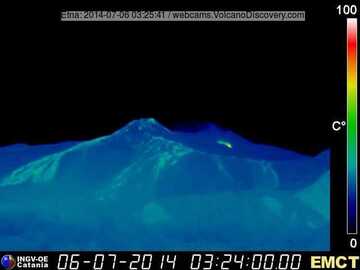
Thermal image of the small lava flow this morning (Monte Cagliato webcam, INGV Catania)
A new effusive vent opened yesterday afternoon on the eastern base of the North-East crater feeding a small lava flow.
Weak activity continues at the New SE crater
Update Wed 02 Jul 14:45
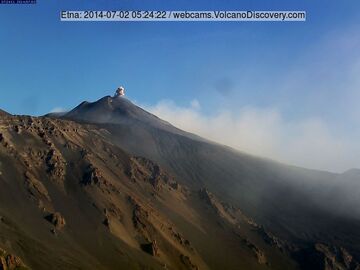
Ash emission from the New SE crater this morning.(EtnaTrekking webcam)

Weak explosion at Etna's NSEC (Montagnola webcam, INGV Catania)
Occasional weak explosions continue at the New SE crater. The volcanic tremor signal is still low.
Eruption ends
Update Thu 19 Jun 09:18

Thermal image of the New SE crater (INGV webcam)

Current tremor amplitude (ESLN station, INGV Catania)
The latest eruptive episode at the New SE crater, which again grew a few meters during this time, is now over. The lava flow is no longer active and there are no (or only very weak and sporadic) explosions at the crater itself. Tremor has descended back to low levels.
Update Wed 18 Jun 17:43
Civil protection reacts "fast": access has now been limited to 2500 m.
Update Wed 18 Jun 16:21
Activity and tremor have further decreased - it seems that the latest eruptive (explosive-effusive) phase at the New SE crater is coming to an end.
A
series of photos taken during 15-16 June has been posted
here.
Update Wed 18 Jun 17:41
This morning, weak strombolian activity and lava effusion were still going on. Marco Fulle who is still on location took this picture of the scene complete with a rare steam ring.

The lava flows from Etna's New SE crater this morning (photo: Marco Fulle)
Activity decreases
Update Tue 17 Jun 07:59
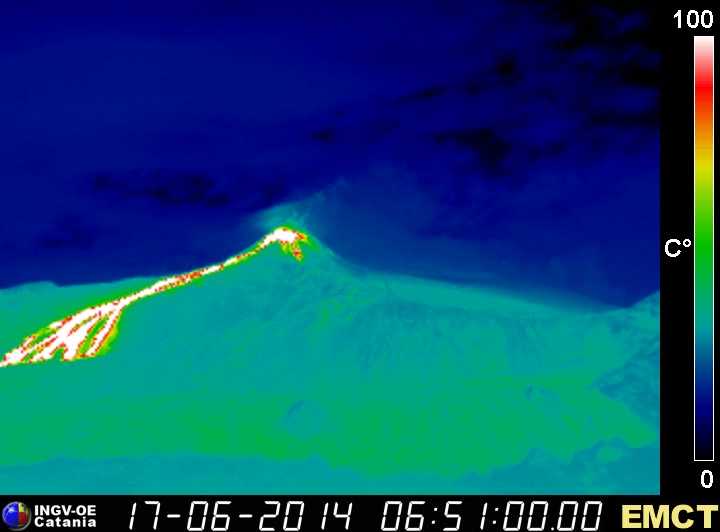
The lava flows from Etna's New SE crater seen on the thermal webcam on Monte Cagliato (INGV Catania) this morning

Current tremor amplitude (ESLN station, INGV Catania)
Activity continues with little changes, at fluctuating and overall slowly decreasing intensity, reflected also by the tremor signal. Last evening, liquid lava spattering from the central vent of the New SE crater occurred at rapid succession reaching heights of 50-150 m and often throwing incandescent material to the upper outer flanks of the cone.
Lava flows continued to descend through the channel on the eastern side of the cone and spread into several channels on the upper half of the Valle del Bove wall, but not extending beyond the fronts emplaced during yesterday night.
The situation this morning is similar, but the spattering at the summit has decreased.
Lava flows into Valle del Bove
Update Mon 16 Jun 15:49
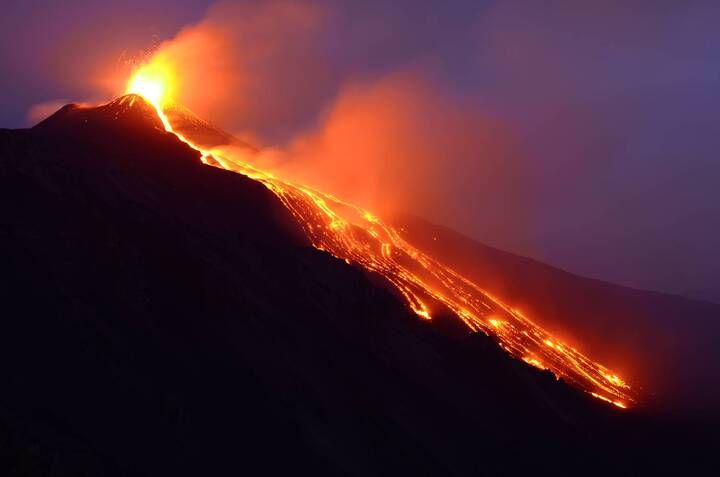
Etna's lava flows this morning (photo: Marco Fulle)

Current tremor amplitude (ESLN station, INGV Catania)
Lava effusion and pulsating low lava fountains continued from the New SE crater throughout the night and today. Tremor remains at fluctuating elevated levels but with a now slightly decreasing trend. The lava flows have descended the western slope into the Valle del Bove where they spread into several broad fronts.
Paroxysm from New SE crater ?
Update Sun 15 Jun 16:52

Eruption at Etna's New SE crater

Current tremor amplitude (ESLN station, INGV Catania)
A violent phase of explosive / effusive activity began over night. Strombolian activity at the New SE crater and volcanic tremor started to increase last evening. This increase continued throughout the night and this morning,- great luck for those on our current tour to Stromboli - Vulcano and Etna.
At the moment, tremor is currently stagnating, and it is not clear whether it will culminate in a true paroxysm (phase of lava fountaining).
Near-continuous explosions from the several vents at the summit of the NSEC occur in rapid succession and eject glowing spatter to heights of 100-200 m during in what could be described as pulsating lava fountains. A vent at the eastern part of the summit occasionally ejects dark jets of ash and brown ash plumes rise from time to time from the northeastern rim of the crater, presumably from collapse events.
Unfortunately, heavy cloud cover , approx. 10 cm of fresh hail and thunderstorm activity prevented detailed observations during most of the early afternoon.
Starting from early this morning, several lava flow headed slowly towards the Valle del Bove rim started to descend from the summit through the valley on the SE side of the crater.
Update Fri 13 Jun 21:53

Strombolian explosion at Etna's NSEC this evening (Radiostudio7 webcam)
No changes in activity have occurred. Sporadic small strombolian explosions continue from the summit crater of the New SE crater. Tremor is low.
Activity continues at the New SE crater
Update Tue 10 Jun 13:14
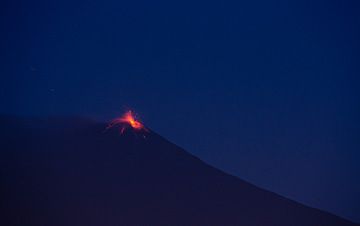
Strombolian activity at Etna's NSEC seen from Catania
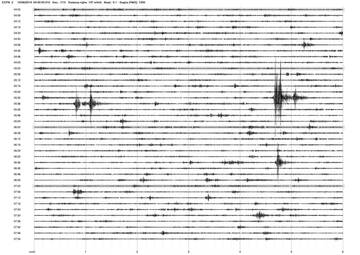
Seismic signal this morning at ECPN station ( by courtesy of INGV-OE Catania)
Mild strombolian activity is still continuing at the New SE crater.
A short sequence of more energetic seismo-volcanic events occurred this morning most probably at Bocca Nuova crater.
It wasn't visible on webcams but only on the seismic signal.
Tremor is currently low.
Ash emissions from the New SE crater and partial collapse on its eastern flank
Update Sun 08 Jun 17:57

Partial collapse on the eastern flank of the New SE crater ((Radiostudio7 webcam)

Ash emission from the New SE crater this morning.(Radiostudio7 webcam)
Glow and ash emissions continue to be observed at the summit vent of the New SE crater. The intensity of this still weak activity slowly increased this morning with 5-10 small explosions per hour.
A small event this afternoon at 13:42 (local time) from the New SE crater produced a reddish-brown ash plume generated by partial collapse on the upper part of the eastern flank of the cone.
Continuing mild strombolian activity at NSEC
Update Sat 07 Jun 09:25
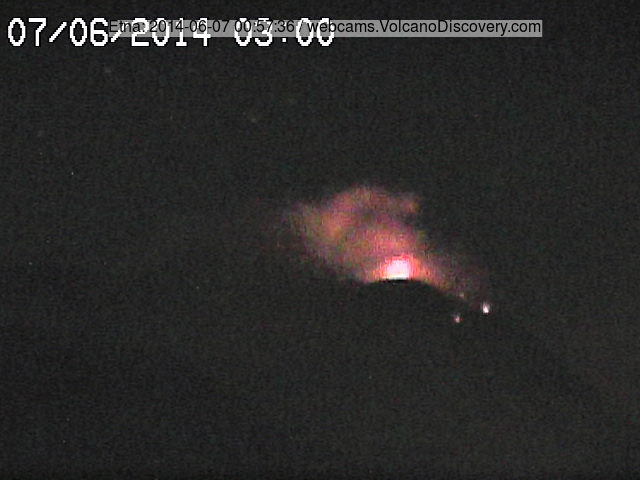
Strombolian explosion at Etna's NSEC past night (Radiostudio7 webcam)
No particular changes have occurred recently. Very sporadic and weak strombolian explosions continue at the summit vent of the New SE crater. Bocca Nuova also continues to produce sporadic ash emissions.
Activity decreases
Update Sun 01 Jun 11:40
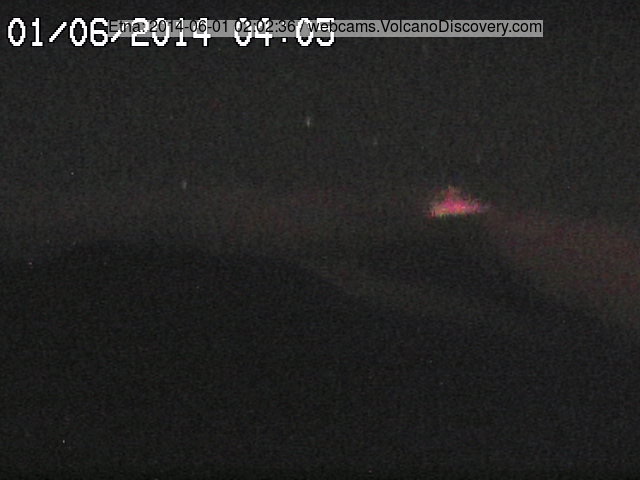
Weak (but among the strongest during past night) strombolian activity at the New SE crater
Activity has decreased. No new ash emissions from the Bocca Nuova could be noticed on webcam images and the strombolian activity at the New SE crater, although still present, has weakened and become much more sporadic as well.
Ash emissions from Bocca Nuova and intermittent strombolian activity at New SE crater
Update Sat 31 May 10:16
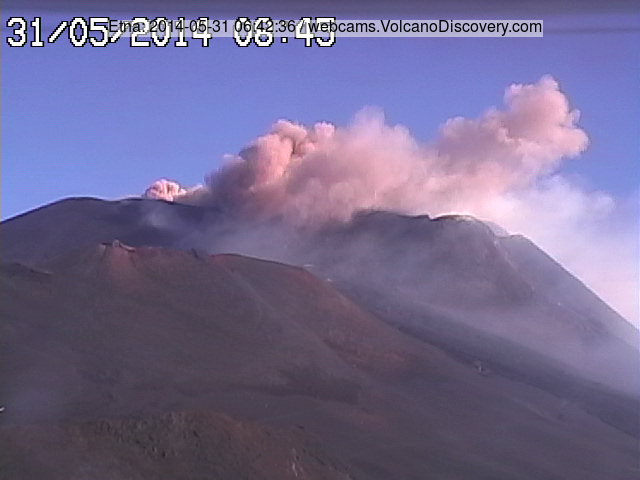
ash emission from Bocca Nuova this morning

Current tremor signal (ECPNZ station, INGV Catania)
Although tremor dropped significantly yesterday evening, mild strombolian activity from the New SE crater continued throughout the night. This morning, new ash emissions from the Bocca Nuova occurred again. Whether this announces a new phase of (different) activity will have to be seen...
Video from this night's activity:
Update Tue 27 May 17:21

Strombolian explosion at Etna's NSEC (Radiostudio7 webcam)
Weak strombolian activity continues with little variation from the New SE crater. A slightly increasing trend of tremor amplitude can be observed over the past days.
Update Mon 12 May 00:54

Strombolian activity at Etna's NSEC this evening seen from Catania

Current tremor signal (ECPNZ station, INGV Catania)
Near-continuous weak strombolian activity is visible from the New SE crater. Tremor is currently low.
Update Mon 05 May 22:55

Weak strombolian activity at Etna's NSEC (Montagnola webcam, INGV Catania)

Current tremor signal (ECPNZ station, INGV Catania)
Sporadic small explosions continue at the New SE crater sometimes with pyroclastic material ejected outside the crater.
In April the seismic tremor was characterized by regular cyclic increases of amplitude forming evident stripes on seismograms. This phenomenon called "banded tremor" gradually became less evident and seems ended on 2 May coincident with a strong seismo-volcanic event occurred most probably at the Bocca Nuova crater.
Update Fri 02 May 23:17

Current tremor signal (ECPNZ station, INGV Catania)
A seismo-volcanic event occurred this night at 23:00 (local time) most probably from the Bocca Nuova crater. It wasn't visible on webcams but only on the seismic tremor and infrasound signals.
First visit to our site? If you havn't done it yet,
download the Volcanoes & Earthquakes app to get one of the fastest volcano news online:
Android |
IOS




























































